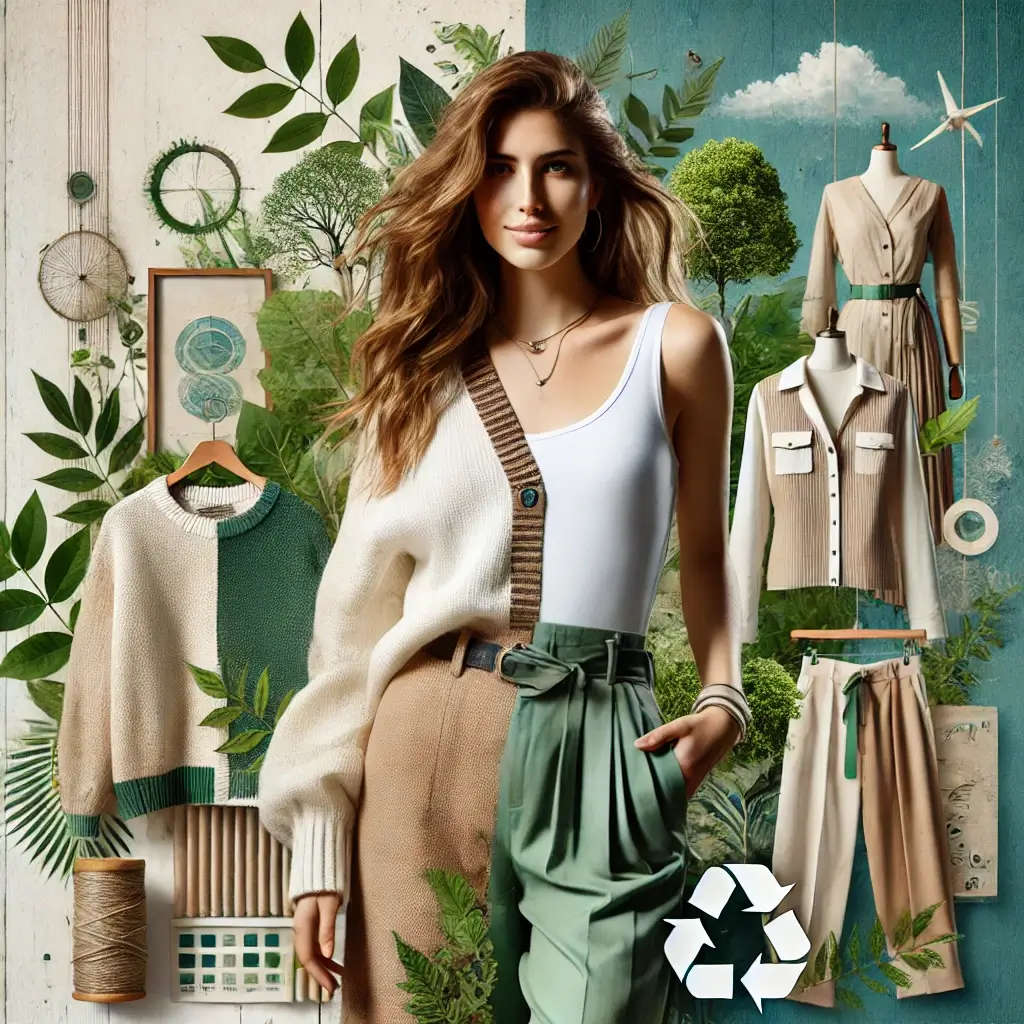
The Rise of Sustainable Fashion: How Eco-Friendly Choices Are Reshaping the Industry
Table of Contents
In recent years, sustainability has emerged as a key focus across multiple industries, with fashion being no exception. The growing awareness of environmental issues, combined with the increasing popularity of conscious consumerism, has led to a significant shift in how clothes are produced, consumed, and disposed of. Sustainable fashion, often referred to as “eco-fashion,” is now more than just a trend—it’s a movement. As consumers become more conscious of their purchasing decisions, many are turning to brands that prioritize ethical production, environmental responsibility, and sustainable materials. This blog will explore how the rise of sustainable fashion is reshaping the industry, why it’s important, and how individuals can embrace eco-friendly choices in their wardrobes.
Understanding Sustainable Fashion
Sustainable fashion refers to clothing, accessories, and footwear that are designed, manufactured, and distributed in ways that minimize environmental impact and ensure ethical labor practices. The core of sustainable fashion lies in three principles: reducing waste, using environmentally friendly materials, and ensuring fair working conditions.
Key aspects of sustainable fashion include:
- Eco-friendly Materials: Many sustainable fashion brands use organic cotton, hemp, bamboo, and recycled materials. These fabrics require fewer pesticides, use less water, and have a smaller carbon footprint than conventional fabrics.
- Ethical Manufacturing: This aspect focuses on fair labor practices. It ensures that workers are paid fairly, work in safe conditions, and are not exploited. Sustainable brands often opt for local production to reduce the carbon footprint associated with global supply chains.
- Waste Reduction: Sustainable fashion also addresses waste in the industry by promoting recycling, upcycling, and creating garments that are designed to last longer. The emphasis is on quality over quantity, encouraging consumers to buy less and choose carefully.
- Transparency: Brands that embrace sustainability often provide detailed information about their supply chains, allowing consumers to make informed decisions. Transparency in sourcing, production, and environmental impact is a hallmark of sustainable fashion.
The Impact of Fast Fashion

Before diving into the rise of sustainable fashion, it’s important to understand the challenges it’s attempting to combat—most notably, fast fashion. Fast fashion refers to the mass production of cheap, trendy clothing that is quickly made and discarded, often after only a few wears.
Fast fashion is incredibly harmful to both the environment and human labor. It relies on synthetic, non-biodegradable fabrics, which contribute to enormous textile waste. The fashion industry is responsible for about 10% of global carbon emissions, with the production of textiles and garments being one of the largest polluting industries in the world.
Additionally, fast fashion brands often cut corners in terms of labor rights, exploiting workers in low-wage countries. This has led to poor working conditions, unfair wages, and even human rights violations in some cases. The desire for cheap, trendy clothing has created an unsustainable model, both environmentally and ethically.
How Sustainable Fashion is Reshaping the Industry
- Consumer Awareness and Demand
One of the driving forces behind the rise of sustainable fashion is the increasing awareness among consumers about the environmental and ethical implications of their purchasing decisions. More people are learning about the impact of fast fashion, and as a result, they are choosing to support brands that align with their values.
Many consumers are now asking important questions: Where do my clothes come from? What are they made of? Who made them? This growing consciousness is putting pressure on fashion brands to be more transparent and adopt sustainable practices. Consumers are increasingly voting with their wallets, supporting companies that prioritize sustainability and ethical practices.
- Innovative Materials and Processes
One of the exciting developments in sustainable fashion is the innovation in materials and manufacturing processes. New technologies and fabric innovations are making it possible to create clothing that is both stylish and eco-friendly.
For example, recycled polyester, made from plastic bottles, is increasingly used in clothing, reducing the need for virgin polyester. Additionally, fabrics made from organic materials such as organic cotton, Tencel (made from wood pulp), and Piñatex (a leather alternative made from pineapple leaves) are gaining popularity.
Brands are also embracing zero-waste production techniques, where clothing patterns are designed to minimize fabric waste. This includes using leftover fabric to create accessories or repurposing scraps in new garments. Such practices are making fashion more sustainable without compromising on style.
- Secondhand and Upcycled Fashion
The secondhand market is booming, as people become more aware of the environmental cost of buying new clothing. Thrift stores, consignment shops, and online platforms like Depop, Poshmark, and ThredUp are making it easier for consumers to buy and sell pre-loved clothing. This trend not only reduces textile waste but also helps in promoting a circular economy, where clothes are reused, recycled, and repurposed.
Upcycling is another key aspect of sustainable fashion, where old garments are transformed into new, high-quality pieces. Designers and independent creators are finding innovative ways to repurpose old clothes into unique, one-of-a-kind items, reducing the need for new production.
- Circular Fashion and Clothing Rental
Circular fashion is a concept that aims to extend the lifecycle of garments by focusing on recycling, reusing, and refurbishing clothes instead of discarding them. Brands are designing products with the intention of them being recycled at the end of their use. Some companies even offer take-back programs, where customers can return old garments to be repurposed or upcycled.
Additionally, clothing rental services are on the rise, allowing consumers to rent high-quality, designer pieces for special occasions. This reduces the need for individuals to purchase items they might only wear once or twice, further curbing the demand for fast fashion.
- Slow Fashion Movement
In contrast to the fast fashion industry’s quick turnover of styles, the slow fashion movement advocates for quality over quantity. This approach encourages consumers to buy fewer, well-made items that will last longer. The slow fashion philosophy emphasizes thoughtful purchasing, encouraging people to invest in durable, timeless pieces instead of chasing after fleeting trends.
By shifting focus away from disposable clothing, slow fashion promotes a more sustainable model where garments are cherished and cared for, rather than discarded after a few uses. This approach is gaining momentum as people realize the value of investing in high-quality, long-lasting clothing.
How to Embrace Sustainable Fashion
As consumers, there are several steps we can take to embrace sustainable fashion and reduce our environmental footprint:
- Choose Quality Over Quantity: Instead of purchasing cheap, trendy clothing, invest in high-quality, timeless pieces that will last for years.
- Buy from Sustainable Brands: Support brands that prioritize eco-friendly materials, ethical manufacturing, and transparency in their production processes.
- Shop Secondhand: Consider buying secondhand clothes from thrift stores or online platforms to reduce waste and support the circular fashion economy.
- Care for Your Clothes: Extend the lifespan of your garments by washing them less frequently, repairing them when needed, and storing them properly.
- Participate in Clothing Swaps: Organize or attend clothing swaps with friends to exchange garments you no longer wear, giving them a second life.
- Educate Yourself: Stay informed about the environmental and ethical implications of your purchasing decisions, and be conscious of the brands you support.
Conclusion

Sustainable fashion is not just a passing trend; it is the future of the industry. As awareness grows about the environmental and ethical challenges of the fashion world, both consumers and brands are embracing the principles of sustainability. By making informed choices, supporting ethical brands, and adopting eco-friendly practices, we can all play a part in reshaping the fashion industry for the better. The shift toward sustainability offers an exciting opportunity to create a more ethical, environmentally conscious, and innovative fashion industry one that values people, the planet, and style. So, next time you’re shopping for clothes, think about the impact of your choices, and take a step toward a more sustainable wardrobe.

